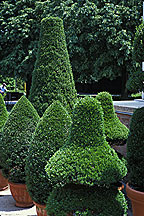 Training plants is a garden art form. At its most ornamental and intricate, the art of training plants becomes topiary.
Training plants is a garden art form. At its most ornamental and intricate, the art of training plants becomes topiary.
Trees or shrubs can be artfully pruned into fanciful figures or geometric shapes. Most gardens in the Midwest favor the geometric look in training plants. Consider the number of precisely pruned yew and boxwood shrubs — in globes, flat rectangles, cones, or pyramids. Sunny gardens might feature walls of sheared arborvitae or specimen junipers, carefully clipped in sentinel fashion.
Standards and Topiaries in Containers
European gardens often made use of clay or stone pots planted with semitropical shrubs grown either as standards or as tightly pruned topiaries. A standard is a plant trained to a single trunk or stem with a distinct shape created by its leaves and flowers at the top of the trunk. Standards lend a formal air to a patio or pool, walkway, or front door. Plants suited to this style of topiary are ivy, tree roses, hydrangeas, fuchsias, hibiscus, or woody herbs like myrtle or rosemary. In temperate climates, these potted plants can be left outdoors year-round; in the Midwest, a woody plant in a pot would need winter protection.
Espalier
Fruit trees are often trained as espaliers. Using guide wires and careful pruning techniques, crabapple, pear, or apple trees can be encouraged to grow in flat decorative patterns against brick or wooden walls. Fan shapes, diamond patterns, and other designs are possible, depending on how the developing tree is trained and pruned. The challenge is to allow the tree to flower and produce lush foliage and even fruit in its restricted environment. Espalier is also a creative way to grow fruit-producing trees in limited space.
Parterre
Tightly clipped or sheared low evergreens can provide a smooth green surface 12 months of the year. This formal element is used to advantage when contrasted with beds of bright flowers or foliage arranged in a geometric pattern.
Knot Garden
A form that dates to colonial days is the formal herb knot garden, created with a design that has an entwined pattern. English cottage gardens as well as early American gardens always included herbs, which were allowed to grow in abundance, often escaping into the cultivated garden areas where they would "volunteer" seedlings for years to come. The concept of a knot herb garden was an attempt to combine utilitarianism with formal gardening. Thyme, lavender, and rosemary are three of the woody herbs suitable for this style. Gardeners today can borrow from this concept and create knot gardens using creeping ground covers, dwarf sedum, and plants other than herbs.
Living Walls
Instead of putting up a chain link or wooden fence, gardeners who desire their privacy might consider growing arborvitae or yew hedges to wall proportions, thereby creating a living wall. The proper selection and siting of these occasionally overused shrubs can produce a long-lived, green garden backdrop. As a whimsical gesture, tiny "windows" can be cut into the wall, allowing the gardener a private view of a vista beyond.
Pleaching
A boulevard or allée lined with tall, carefully pruned trees might be appropriate for large-scale country gardens. Gardeners in small-scale or urban sites can imitate this concept by planting small trees close together and training and pruning the branches to grow along wires that connect the trees. This technique for training plants is known as pleaching. Over time, a solid tree wall will result. Apple or thornless hawthorn trees are two good choices as plant material.
Flowering Shrubs
Colorful flowering shrubs can be pruned into mounds or domes. In early spring, they burst into bloom, creating magnificent dots of color that contrast so beautifully with evergreens. This form of training plants is in the Japanese manner where magnolia, cherry, azalea, and rhododendron shrubs are pruned to imitate other natural forms, like clouds and stones.
Examples of all forms of trained plants can be seen throughout the 25 display gardens of the Chicago Botanic Garden.

